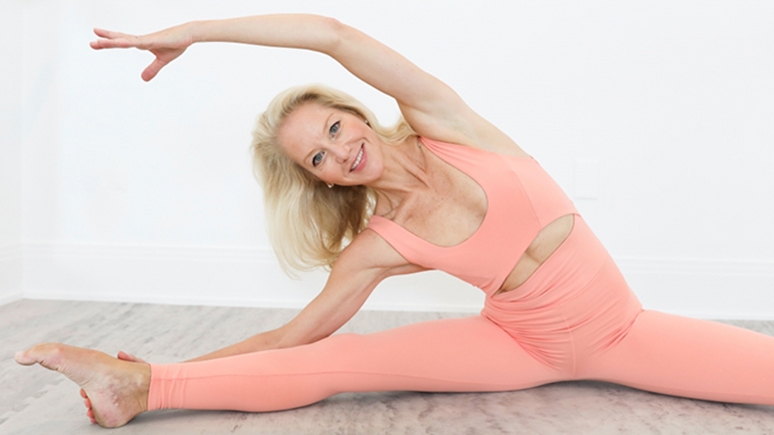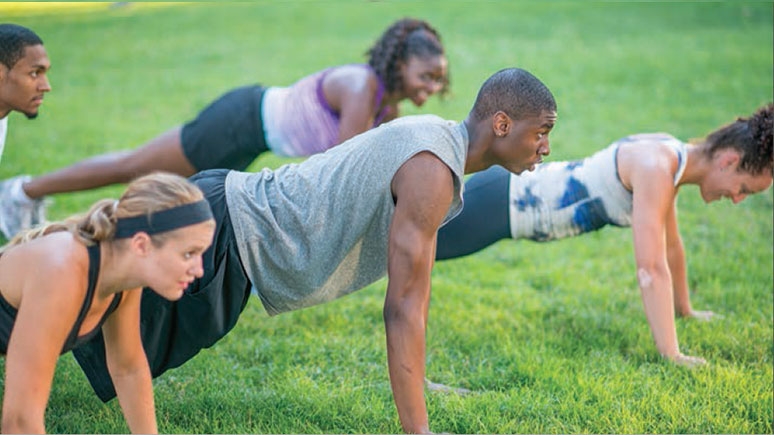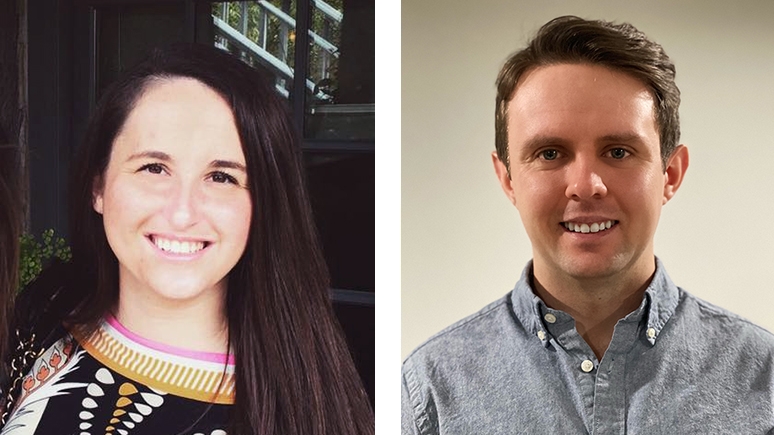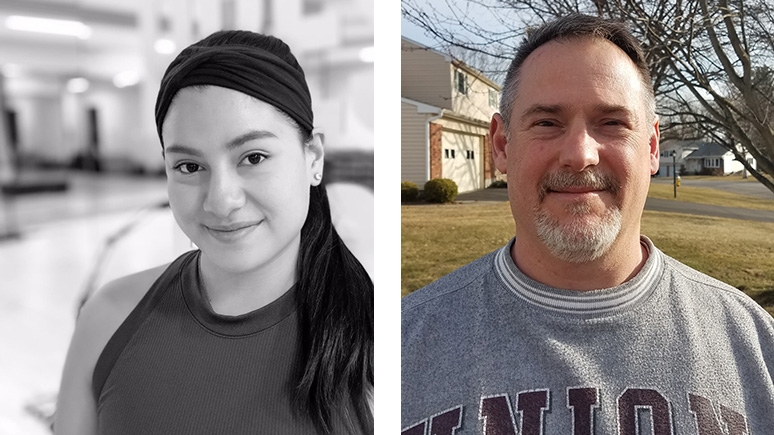Routines can make us feel like we're stuck in a rut, going nowhere. Synonyms for the word routine—monotonous, tedious, unchanging—pretty much say it all.
But routines also keep us organized, help us manage stress and keep us healthy. Without them, it'd be insanity all the time.
And that's never been more obvious. COVID-19 upended every routine imaginable, including fitness routines.
But people are nothing if not adaptable. Alumni in the fitness industry found ways to keep exercise in clients' lives, as well as their own.
How? They leveraged technology—in all its frustrating, amazing glory.
From solo-owned studios to large companies, everybody in the fitness industry either started offering virtual workouts or increased their online options and bandwidth.
For entrepreneurs, this has often meant revamping an existing business or building a completely new one.
Belinda Gower '94 founded her Pilates business, Belinda Gower Studio, in Concord, Mass., in 2014.
Until the pandemic forced her to close in March 2020, she offered barre classes, mat classes and reformer classes in her studio. And since her studio is attached to her home—and a fall 2020 survey showed less than a quarter of her clients were willing to resume in-person classes—the space has remained shuttered.
"A few times I forgot to press ‘record’ and taught an entire class without recording it. So I had to re-film the same class twice." — Jenna Langhans '13 , owner of Ballet & Bells
But that hasn't stopped Gower from meeting the fitness needs of her clients— or herself for that matter.
"I realized people were counting on me and I wanted to help. I also realized that my clients motivated me to stay fit as much as I did them," Gower said. "So I decided to give online teaching a try."
In November 2020, she launched barre@home, a collection of Pilates-focused barre classes anyone can do at home.
She started out on Instagram Live, which worked very well, but her classes were so popular she quickly outgrew it.
"I loved my Instagram Live experience. My pool of clients went from friends and locals to an international following. However, teaching for free from a tiny vertical box wasn't sustainable," Gower said. "I wanted to find a higher quality format that worked on multiple devices and to monetize my business."
She switched to uscreen.tv and while it's running smoothly now, getting used the technology wasn't easy.
"It was a steep learning curve! I hired a videographer to film the first few videos and show me how to edit them," Gower said. "At the beginning, a 55-minute workout video took me 8 hours to complete between filming, editing, music overlay and uploading."
The set-up is also the hardest part of teaching livestreamed classes.
"I have to cross-check the music (must be copyright free), the lighting, the camera angle (my arms and legs must be visible), and pray my kids' Zoom classes don't take up all my bandwidth," Gower said. "I've had crashes, bloopers and I've been ‘shutoff' by Instagram for inadvertently using copyrighted music."
"It's complex," she added. "It makes in-person teaching look like a piece of cake!"
Jenna Langhans '13 can relate.
While she has plenty of experience teaching on-camera for platforms like DailyBurn, Cityrow Go and ClassPass Live (of which she's a founding trainer), the pandemic threw a big wrench into things.
When the studios from which she normally taught classes closed, she had to scramble to figure out how to meet the needs of her clients another way.
Thus, Ballet & Bells was born. Its membership program consists of four livestreamed classes a week focused on kettlebell skills, athletic training, HIIT and barre. Langhans, a certified personal trainer, also offers pre-recorded workouts on her website.
"Our sales skyrocketed overnight and we had to reforecast everything. We had to get creative with finding ways for our coaches to safely produce more content." — Tamara Linde '10, head of digital marketing at MYX Fitness
"A few times I forgot to press ‘record' and taught an entire class without recording it. So I had to re-film the same class twice," said Langhans, who is based in New York City. "My laptop recently died so I was teaching from my phone and the quality wasn't as good. Sometimes the mic wouldn't work and once, Zoom crashed and I couldn't start a class. The list goes on."
She's also had to take on her own marketing, hire someone to build her website and provide technological assistance, and figure out how to succeed in the competitive online fitness market.
"Owning your own business is a double-edged sword. While you get to choose your own prices and hours, you also have to find your own clients in an over-saturated industry on Instagram that offers free workouts and promises quick fixes," Langhans said. "Anyone can post a workout on social media without having any training knowledge or certifications, which can be frustrating."
But she's overcoming that. Ballet & Bells is growing and the larger platforms she teaches for are again making content.
Improving virtual
But those larger platforms have had to shift gears, too, or in the case of MYX Fitness, step on the gas.
The Connecticut-based startup was founded in 2017. As an interactive fitness platform, it streams on-demand and live workouts (coming soon) to clients with MYX set-ups at home.
"Our fitness solution has three main pillars: heart rate training, cross-training and positive coaching. Every MYX order comes with a commercial grade cycle bike and Polar heart rate monitor," explained Tamara Linde '10, head of digital marketing at MYX. "After taking an initial assessment, users are able to see customized heart rate zones in every workout to make sure they are working out as effectively and efficiently as possible. The goal is to help you work out smarter, not harder, and avoid overtraining and overall fatigue and injury."
"And our coaching staff are all handpicked by our director of fitness and scouting team," she added. "We wanted coaches who are real, relatable people but also experts in their fields. Our goal is to make fitness more approachable."
The company's way of doing things, which was gaining traction before the pandemic, became even more popular as COVID shutdown gyms and studios everywhere. The increased demand meant MYX had to get equipment and programming to more people more quickly.
Our sales skyrocketed overnight and we had to reforecast everything. We had to get creative with finding ways for our coaches to safely produce more content," Linde said. "This year we also began testing into TV, both streaming and linear. It was really exciting to concept a TV spot with our team, go into production and then see our ad live on the TV screen."
MYX is set to merge with powerhouse fitness company Beachbody this summer as part of a SPAC through Forest Road Acquisition Company. The merger is valued at $2.9B.
Even at-home fitness giant Peloton had to pivot a bit when COVID-19 hit.
"The pandemic has definitely impacted the things we do at Peloton and has forced us to adapt our software and workflows to meet the unique demands created by social distancing,” said Taylor Ellsworth '16, a software development engineer in test at Peloton in New York City. "Instead of filming live classes in our New York and London studios, we had to move the whole operation to our instructors’ living rooms."
"When you develop a steadier routine, you begin to feel more motivated. Exercising your mind and body can allow you to reconnect with yourself and take control of your health." — Julia Delaney '18, trainer
"This required a lot of teamwork from several different teams,” he added. "The production, content, streaming and engineering teams all had to work together to make changes in order for us to keep filming fitness classes."
Ellsworth, who is responsible Peloton's member website and instructor app, is tasked with writing automated tests to help ensure the company consistently delivers high-quality products. These tests catch software problems before the software gets into the hands of members and instructors.
During the pandemic, my team had to make updates to the instructor app to make the live-from-home experience possible," Ellsworth explained. "Since everyone was working remotely, this required more communication and troubleshooting than it would have if we were in an in-person setting. Thanks to great teamwork and leadership, we were able to accomplish this successfully."
But of course, not all fitness happens online – even during the pandemic. In-person options have slowly started to return.
Virtual and in-person
Julia Delaney '18, a tier II trainer at Equinox in New York City, has been working with clients online and in the gym. She specializes in athletic speed and agility training, strength training and weight loss.
For the virtual portion of her job, she admits it was challenging at first.
Initially, it was difficult to change how we look at working out. Clients who were used to going to the gym and lifting heavy equipment were forced to go back to the basics,” Delaney said. “But we learned the benefits of bodyweight and resistance training, which can be done in your living room. And virtual sessions allowed my clients to feel accountable to their fitness goals."
When gyms began reopening, other changes to workout routines were necessary.
"I learned how to adjust to wearing a mask. Initially, it can limit your oxygen intake and hinder your depth perception and balance,” Delaney said. “I make sure to prepare my in-person clients and make sure they don’t feel discouraged when they first try wearing one."
"I also make sure to maintain a thoughtful distance so that everyone feels safe,” she continued. “Additionally, there is limited occupancy and temperature checks are performed when you first walk into the gym. It is also protocol to wipe down equipment before and after use."
While all this has been an adjustment for Delaney and her clients, everyone has just been happy to get back into some sort of exercise routine.
"My clients appreciate the escape and the ability to spend an hour on themselves, especially if they are home all day,” Delaney said. “When you develop a steadier routine, you begin to feel more motivated. Exercising your mind and body can allow you to reconnect with yourself and take control of your health."
"I believe fitness is good for the body and the soul."
And she's not alone. The many benefits of movement are a big reason demand for accessible fitness programming increased during the pandemic.
The benefits
There are the obvious physical benefits—from cardiovascular health to strength, endurance and flexibility—and then there are psychological benefits.
"The emotional burdens of the pandemic have been widely recognized," Linde said. "Honestly, I get choked up reading some of the stories people have sent in about how MYX has helped them through this."
"We've heard from first responders who work 24-hour shifts and use MYX as their 'me time' to escape the stress of their jobs," she continued. "We've heard from parents who have had to become teachers who greatly benefit from being able to squeeze in a MYX workout at home."
The fact that fitness goes beyond the body is no surprise to Wally Bzdell '94. A sports psychologist and New York State licensed psychologist, he owns Bzdell Sports Psychology in Scotia, N.Y.
"We all hear plenty about the health benefits of exercise, but an area that gets less attention is how exercise is an important part of recovery for us all," he said. "And in stressful times like these, recovery becomes more important."
"There are five pillars of recovery I share with student athletes and clients—thinking well, sleeping well, moving well (exercise), eating and hydrating well, and connecting with others," Bzdell continued. "We actively need to engage in each aspect to be at our best. So not only are there the physical benefits of exercise, without it you can never fully recover and recharge from the stressors life throws at us."
To help his own clients fully engage with each of these aspects during the pandemic, Bzdell developed a series of short videos for them to watch before their virtual sessions.
"Online meetings have replaced face-to-face meetings. The unexpected benefit of this is that teams I would normally travel to meet with a couple times per month I can see every week," he said. "This is a practice that will likely stay in place even after travel and other restrictions are lifted."
Another unexpected benefit is what Bzdell has learned from the pandemic.
The most important principle that has been reinforced is the power of one's own perspective,” he said. "Our psychological framework is critical and when we develop optimism, control and growth mindset, we act and engage in the world with greater purpose, passion and resilience."






